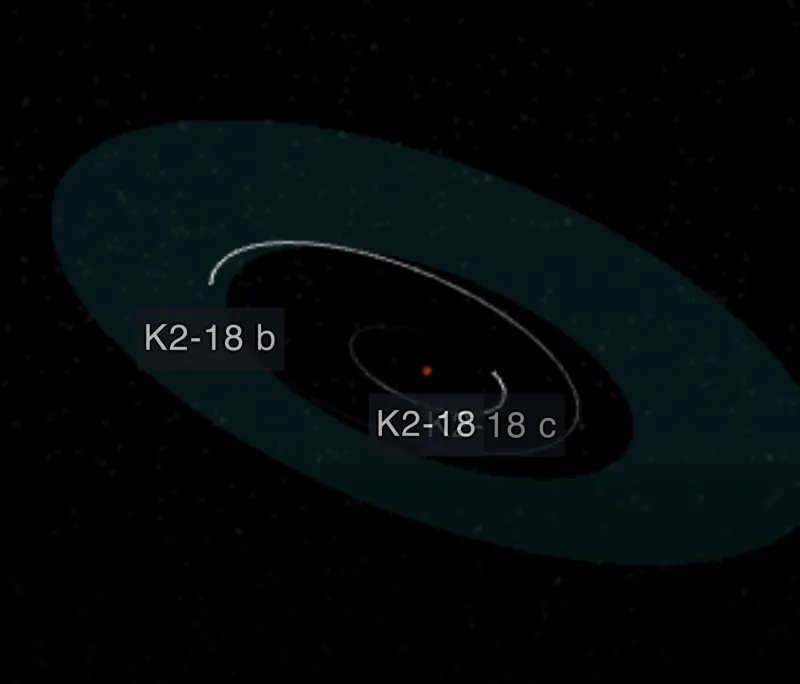I. Introduction
In the endless tapestry of the cosmos lies a world both intriguing and distant: K2–18b. Located a staggering 124 light-years away from our own blue planet Earth, this enigmatic exoplanet orbits a red dwarf star named K2–18. Its discovery, initiated by the watchful eye of the Kepler space telescope, opened a portal to a realm of possibilities.
K2–18b isn’t just another celestial body; it’s a Mini-Neptune, eight times the mass of Earth. However, what truly stirs the imagination is its orbit within the star’s habitable zone, where starlight might nurture the existence of liquid water, a vital ingredient for life as we know it.
In 2019, the detection of water vapor in its atmosphere tantalized scientists and skywatchers alike. Now, in 2023, the James Webb Space Telescope has unveiled more secrets, hinting at a world submerged in an ocean beneath a hydrogen-rich atmosphere.
II. A Mini Neptune
K2–18b isn’t your typical planet. It’s what we call a Mini-Neptune, a heavyweight in the planetary realm, about eight times the mass of Earth. But here’s the twist: despite its size, it’s far from Earth-like.
One of its quirks is its quick 33-day orbit around its host star, K2–18, which places it in the star’s habitable zone, a region where conditions for liquid water are just right. Yet, despite this tantalizing setup, K2–18b is more like a distant cousin than a sibling to our planet. It challenges our understanding of what makes a world habitable and beckons us to learn more about the exoplanet.

III. Water Vapor Discovery (2019)
In 2019, scientists made an exciting breakthrough regarding K2–18b — they found water vapor in its atmosphere. Think of it as a cosmic raincheck, suggesting that this distant world might have the building blocks for life. This discovery was a spotlight moment, piquing the interest of scientists and space enthusiasts, turning K2–18b into a celestial star in its own right. It’s a discovery that opened the door to even more questions about the potential habitability of this unique exoplanet.
IV. Discovery and Confirmation
K2–18b wasn’t an easy find. It was initially spotted by the keen eye of the Kepler space telescope in 2015. But astronomers didn’t stop there; they wanted to be sure. So, they called in reinforcements, with the Spitzer Space Telescope and Doppler velocity techniques joining the hunt. Together, they confirmed the existence of this distant world.
What’s intriguing is that they ruled out alternative explanations. It wasn’t a hidden companion star or a pack of planets causing the observations. This rigorous confirmation process laid the foundation for further exploration of K2–18b’s secrets. However, there were some early hiccups, like overestimating the planet’s density due to errors in estimating the star’s radius. But that’s the beauty of science; it evolves as we uncover more about our universe.
V. Habitability and Biosignatures
Now, let’s talk habitability on K2–18b. Despite its similarities to Earth in terms of starlight, K2–18b’s habitability is a puzzle. Some layers of its atmosphere might be too hot for life, while others with water could be just right.
But here’s the twist: identifying signs of life on K2–18b isn’t as simple as it seems. While microorganisms from Earth can survive in hydrogen-rich atmospheres, traditional biosignatures might not work here. We’d need different markers to detect life in this unique setting, a challenge that the James Webb Space Telescope may help tackle in the future. So, K2–18b keeps us guessing, reminding us that the search for habitable worlds is full of surprises.

VI. Hycean Planets
K2–18b has introduced us to a fascinating concept — Hycean planets. These are worlds with both liquid water and hydrogen envelopes. Previously, scientists thought they’d be too hot for life, but K2–18b changed the game. It showed us that these planets might just be cold enough to host life-friendly oceans, thanks to a strong greenhouse effect from their hydrogen blankets.
In essence, Hycean planets, like K2–18b, challenge our preconceptions about where life could thrive in the universe. They expand our understanding of habitability to unexpected places, reminding us that the cosmos is full of surprises.
VII. Latest Observations
Fast forward to September 2023, and the James Webb Space Telescope delivered more exciting news about K2–18b. It found methane, carbon dioxide, and even a hint of dimethyl sulphide (DMS) in the planet’s atmosphere.

Methane and carbon dioxide are crucial in the quest for habitability, while DMS is intriguing because it’s associated with life on Earth. However, further investigation is needed to confirm the presence of DMS and rule out other sources.
These new discoveries keep us on the edge of our cosmic seats, as they could be potential clues to life or its building blocks on K2–18b. The mysteries of this distant world continue to unfold before our eyes.
IX. Conclusion
In our journey to K2–18b, we’ve explored a world that challenges our understanding of habitability and the search for life beyond Earth. This distant Mini-Neptune, with its water vapor, carbon dioxide, and methane hints, keeps us intrigued.
As we look to the stars, K2–18b serves as a reminder that the universe is a tapestry of surprises, where planets like Hycean worlds could rewrite the rules of habitability. Our exploration of K2–18b is far from over, and the quest for understanding its secrets continues, opening new possibilities and sparking our curiosity about the wonders of the cosmos.
X. References
- Kepler Space Telescope Discoveries — NASA
- James Webb Space Telescope — NASA
- “A Hycean World Orbiting a Neptune-Mass Host Star” — The Astrophysical Journal
- “Water Vapor on the Habitable-Zone Sub-Neptune Exoplanet K2–18b” — The Astrophysical Journal Letters
- “The Presence of Methane in Exoplanets Atmospheres” — arXiv